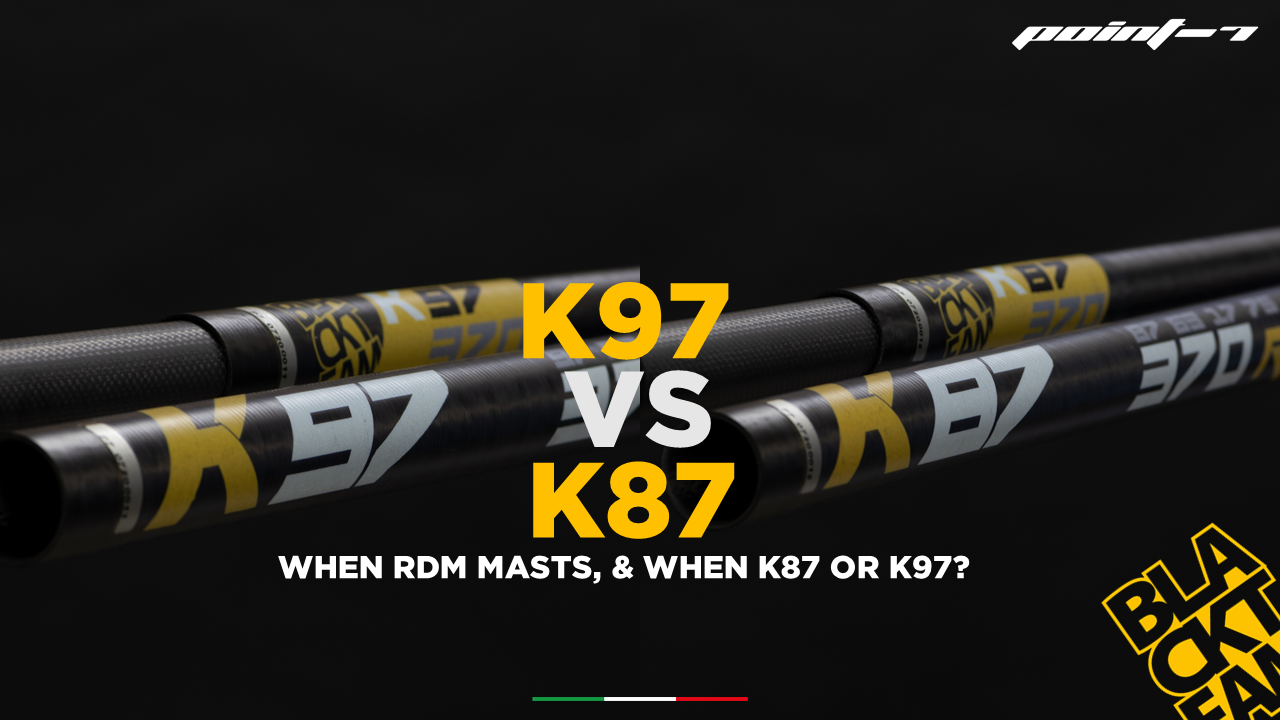
Blog
WHEN RDM MASTS, and when K87 or K97?

It was now some years back when suddenly the rdm masts were presented on the market. There was an enthusiastic rush to change from the Sdm mast, to the Rdm for smaller sail sizes, and especially for wave sails.
Many believe that the Rdm mast is a lighter mast. It is slightly heavier than a Sdm, as the walls need to be thicker to make sure that there is enough strength for its real use, and to allow the mast stability in the sail. What makes it feel light is the handling due to its size and proportions, and not the scale weight.
In smaller sail sizes the Rdm gives good stability, an excellent reflex also for the fact that there is more wall thickness, therefore more material (carbon) to speed up the return to its position after hitting gusts and chop. Something that probably would not be expected. Therefore, also in small slalom racing sail sizes, there is the use of the Rdm masts in the latest designs. The Rdm masts are less used on the bigger slalom sizes as the stability of the mast starts to be less in the longer lengths, it starts to feel also heavier and less performing. For marketing reason some use it; it could be practical for this reason as you could just have all rdm extensions for example, but on the other hand the Sdm is simply better if you want a bigger sail to be lighter and more performing from all sides.
Having more material around the walls diameter it makes the mast stronger in wipe outs which is one of the main reasons why it is preferred especially in wave sailing.
We generally advice to use from 400 down the Rdm mast. 430 is a bit of a hybrid size, where on some sail models the Rdm is still working well and makes sense, but also the 430 Sdm starts to take over with advantages on other sail models. From 460 up is obvious the Sdm performance beats the Rdm.
When choosing an Rdm many think that as they will use it in the smaller sail sizes in stronger it will be less important to have a good mast, and therefore less careful on the choice of mast and curves. The stronger the wind, the harder the conditions. But, if you have the perfect mast, the hardest conditions will become more controllable and easier. If you have a wrong mast in strong wind, it’s going to be even more tough then having the wrong mast in medium winds. Light winds and strong winds are where gear needs to be at its best performance. Its like a good sailor, you see it in extreme light wind or in strong wind. In medium wind, it’s an easier condition for everyone.
We keep reminding that all mast looks the same from the outside, but the inside of the masts is very different. It’s not only the Imcs, the curve, but also the material used, how the ferrule is placed, the technology used, the reflex in the mast. Even if with 30kg on to measure the Imcs they may seem the same, everything changes once you apply the downhaul on the sail in compression, and that it has to merry the reflex of the sail. So, it’s not only the curve or the IMCS, but there is a lot more into it that will make your sail efficient at 100%. Therefore, we always advice the mast from the sail brand. Yes, all mast will fit inside, but 100% efficiency is obtained with its mast.
The next question once you know why you are buying a rdm mast, is if you should take a K87 or K97. For Point-7 we offer only 2 carbon percentages, therefore 87 and 97%. We do not offer a 60% rdm mast as the weight and performance go too low, that at that point, is better to look for a used mast of 75-85% carbon to target a lower budget. We manged to bring our 80% to have more carbon and made the 87%, keeping the price competitive, and to add a reinforcement to the 100% to bring it to 97% to save it from most common reason that a mast would break in waves.
Often the choice from the pro-riders is not necessarily the highest carbon percentage. They chose the mast according to the use they need. For example, a pure a freestyler prefers a K97 mast as he looks for high reflex and fast pop for air moves. Same goes for those who will buy a pure racing sail in a small size. A wave sailor who believes to use the mast where he needs to be more exact and dynamic, he will use the also the K97, but when they need to go for extreme conditions, or choppy or when they need a more forgiving mast, they prefer to go for the 87: it’s less direct on the arms and can allow softer landing for example. Also, when they travel to big waves in places where they can’t have or find spares, they prefer to have a stronger mast rather than a more reactive. This is the way we have therefore developed our RDM mast. For small Free-slalom sail sizes, also the K87 can be a very good option. A bit less reflex, but more forgiving on the chop and stronger winds.
Not thinking more carbon, more performance, and less carbon less performance, but by placing the 2 model of masts towards the real windsurfing direction they would be used in.
[/col] [/row] [row style=”collapse” padding=”0px 0px 0 0px”] [col span__sm=”12″ divider=”0″ padding=”0px 0 0px 0px” margin=”0px 0 0px 0px”]K97 CARBON MAST: (97% Carbon mast)
[ux_image id=”75110″ image_size=”original” lightbox=”true”]- Best possible performance for your sail.
- Great pumping response and acceleration.
- Best Reflex and weight for a light feeling.
- Extra reinforcements added to increase strength for toughest conditions. Knowing the mast will used in waves and strong wind slalom, we made sure to add the extra reinforcements to increase strength for toughest conditions.
- Bringing a 100% mast close to the durability of an 80% carbon mast
- Most probably the best possible Rdm product on the market
K87 CARBON MAST: (87% Carbon mast)
[ux_image id=”75111″ image_size=”original” lightbox=”true”]- Responsive and sturdy.
- High carbon content and quality for durability.
- A reflex close to a 100% carbon mast that will lighten the feeling of any rig.
- Best compromise between performance and durability,
- at amazing prize
- An extra catapult, an extra crash, long time rigged, this mast will not suffer.
- A touch higher glass content and with a touch lower carbon percentage, for better protection against breakage.
Other Details:
[ux_image id=”75112″ image_size=”original” lightbox=”true”]We keep producing our masts in Italy with best material, latest technology to assure safety of the product.
Inverted Ferrule: The ferrule is part of the top, and not part of the bottom anymore. Therefore, the rdm is now being called RDM-I. After testing with our wave team, the masts, we have discovered that landing hard flat or nosedive jumps, was creating extra stress to the top, where the ferrule would enter it. By having the ferrule being part of the top, the stress is taken out and the tops do not suffer the extra stress that could bring in the worst case to breakages.
[/col] [/row]





